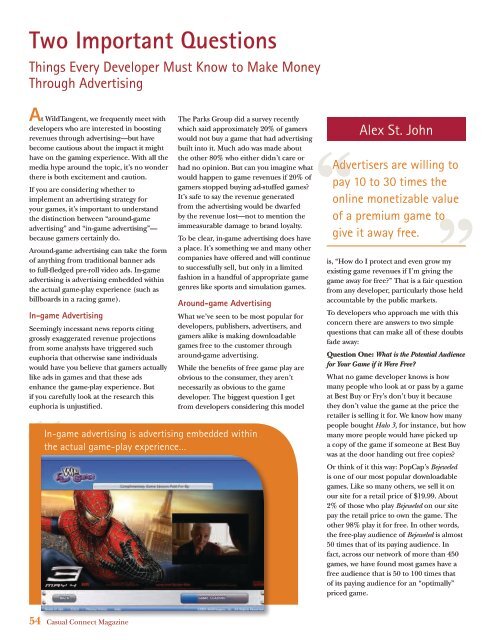Download .pdf - magazine & cover archive - Casual Connect
Download .pdf - magazine & cover archive - Casual Connect
Download .pdf - magazine & cover archive - Casual Connect
You also want an ePaper? Increase the reach of your titles
YUMPU automatically turns print PDFs into web optimized ePapers that Google loves.
Two Important Questions<br />
Things Every Developer Must Know to Make Money<br />
Through Advertising<br />
At WildTangent, we frequently meet with<br />
developers who are interested in boosting<br />
revenues through advertising—but have<br />
become cautious about the impact it might<br />
have on the gaming experience. With all the<br />
media hype around the topic, it’s no wonder<br />
there is both excitement and caution.<br />
If you are considering whether to<br />
implement an advertising strategy for<br />
your games, it’s important to understand<br />
the distinction between “around-game<br />
advertising” and “in-game advertising”—<br />
because gamers certainly do.<br />
Around-game advertising can take the form<br />
of anything from traditional banner ads<br />
to full-fledged pre-roll video ads. In-game<br />
advertising is advertising embedded within<br />
the actual game-play experience (such as<br />
billboards in a racing game).<br />
In-game Advertising<br />
Seemingly incessant news reports citing<br />
grossly exaggerated revenue projections<br />
from some analysts have triggered such<br />
euphoria that otherwise sane individuals<br />
would have you believe that gamers actually<br />
like ads in games and that these ads<br />
enhance the game-play experience. But<br />
if you carefully look at the research this<br />
euphoria is unjustified.<br />
The Parks Group did a survey recently<br />
which said approximately 20% of gamers<br />
would not buy a game that had advertising<br />
built into it. Much ado was made about<br />
the other 80% who either didn’t care or<br />
had no opinion. But can you imagine what<br />
would happen to game revenues if 20% of<br />
gamers stopped buying ad-stuffed games?<br />
It’s safe to say the revenue generated<br />
from the advertising would be dwarfed<br />
by the revenue lost—not to mention the<br />
immeasurable damage to brand loyalty.<br />
To be clear, in-game advertising does have<br />
a place. It’s something we and many other<br />
companies have offered and will continue<br />
to successfully sell, but only in a limited<br />
fashion in a handful of appropriate game<br />
genres like sports and simulation games.<br />
Around-game Advertising<br />
What we’ve seen to be most popular for<br />
developers, publishers, advertisers, and<br />
gamers alike is making downloadable<br />
games free to the customer through<br />
around-game advertising.<br />
While the benefits of free game play are<br />
obvious to the consumer, they aren’t<br />
necessarily as obvious to the game<br />
developer. The biggest question I get<br />
from developers considering this model<br />
“<br />
In-game advertising is advertising embedded within<br />
”<br />
the actual game-play experience…<br />
“<br />
Alex St. John<br />
Advertisers are willing to<br />
pay 10 to 30 times the<br />
online monetizable value<br />
of a premium game to<br />
give it away free.<br />
”<br />
is, “How do I protect and even grow my<br />
existing game revenues if I’m giving the<br />
game away for free?” That is a fair question<br />
from any developer, particularly those held<br />
accountable by the public markets.<br />
To developers who approach me with this<br />
concern there are answers to two simple<br />
questions that can make all of these doubts<br />
fade away:<br />
Question One: What is the Potential Audience<br />
for Your Game if it Were Free?<br />
What no game developer knows is how<br />
many people who look at or pass by a game<br />
at Best Buy or Fry’s don’t buy it because<br />
they don’t value the game at the price the<br />
retailer is selling it for. We know how many<br />
people bought Halo 3, for instance, but how<br />
many more people would have picked up<br />
a copy of the game if someone at Best Buy<br />
was at the door handing out free copies?<br />
Or think of it this way: PopCap’s Bejeweled<br />
is one of our most popular downloadable<br />
games. Like so many others, we sell it on<br />
our site for a retail price of $19.99. About<br />
2% of those who play Bejeweled on our site<br />
pay the retail price to own the game. The<br />
other 98% play it for free. In other words,<br />
the free-play audience of Bejeweled is almost<br />
50 times that of its paying audience. In<br />
fact, across our network of more than 450<br />
games, we have found most games have a<br />
free audience that is 50 to 100 times that<br />
of its paying audience for an “optimally”<br />
priced game.<br />
Question Two: How Many Times Does a<br />
Person Play Your Game Before Finishing it or<br />
Moving on to Another?<br />
Once you know what your free audience is,<br />
you then must know how many times the<br />
average person is playing your game before<br />
either getting bored with it or finishing it.<br />
Knowing this can help you arrive at a perplay<br />
cost of the game, a cost you can either<br />
pass on to the gamer or to an advertiser<br />
willing to sponsor the game on behalf of<br />
the gamer.<br />
Continuing with the Bejeweled example,<br />
we know that on our network the average<br />
player of Bejeweled plays the game about 80<br />
times before moving on, making the actual<br />
value of the game approximately $0.25<br />
per play to its paying audience (based on<br />
a retail price of $20). Since the free-play<br />
audience of Bejeweled (and most other<br />
games) is about 50 times that of its paying<br />
audience, then the value of each free play<br />
across its potential audience is about half<br />
a cent per session (that is, $0.25/50). That<br />
means that an advertiser could sponsor the<br />
game-play at a CPM of $5 ($.005 x 1000)<br />
and the developers would make the same<br />
amount of money as they would from<br />
selling the retail version to the 2% of its<br />
audience willing to pay for it. This math is<br />
essential to understand the online games<br />
business because advertisers are willing to<br />
pay 10 to 30 times the online monetizable<br />
value of a premium game to give it away<br />
free, provided the game is packaged in a<br />
way that enables the advertiser to sponsor it<br />
on a per-session basis.<br />
You can do this math for any game. A<br />
successful game under this model is one<br />
that has a high replay value because the<br />
more plays it gets, the lower the perplay<br />
cost and the more advertisers will<br />
be interested in paying to sponsor free<br />
play. What traditional game publishers<br />
need to understand about taking their<br />
games online is that advertising is just an<br />
alternative payment solution for game-play<br />
that happens to work extremely efficiently<br />
once the developer can correctly transform<br />
a game’s retail price into a correct<br />
CPM value for advertisers. Traditional<br />
publishers also often mistakenly believe<br />
that online distribution should be treated<br />
as an aftermarket for games that have<br />
outlived their retail shelf-life. The truth<br />
is that online distribution offers a means<br />
of getting paid to market a new game—at<br />
an extremely high return and low cost<br />
of goods sold. Traditional publishers,<br />
who are accustomed to the constraints of<br />
marketing in a boxed-game world where<br />
distribution costs make it impossible for<br />
games to market themselves, often waste<br />
this tremendously profitable and viral way<br />
to market new games.<br />
The Bottom Line<br />
The vast majority of the developers<br />
with games on our network have seen<br />
tremendous growth in the size of the<br />
checks we send them every month—simply<br />
because they now know the answers to<br />
those two important questions.<br />
Alex St. John is the CEO and co-founder of Wild-<br />
Tangent, a leading online game publisher and<br />
creators of the Web Driver platform. Alex can be<br />
reached at alex.st.john@casualconnect.org.<br />
<strong>Casual</strong> <strong>Connect</strong> Magazine <strong>Casual</strong> <strong>Connect</strong> Magazine



